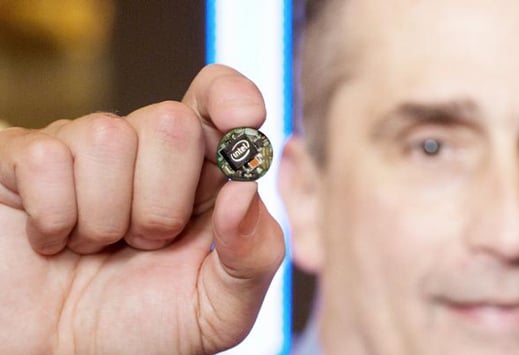CES 2015: Intel Demos a Button-Size Wearable Computer
It just got a lot easier to build wearable gadgets that aren’t so bulky or awkward.

Intel CEO Brian Krzanich showed off a minuscule computer, dubbed Curie, during a keynote speech at the International Consumer Electronics Show in Las Vegas on Tuesday. Krzanich plucked a button off his blazer before explaining that it contained a Curie demo module.
Curie is a sure sign that hardware makers are eager to build wearable devices of all kinds. It also points to the unwelcome size of many existing smart watches and smart glasses.
Intel’s new device will include a Bluetooth low-energy radio, motion sensors, and components designed to rapidly and precisely differentiate between different types of physical activity. Krzanich said Curie will run “for extended periods of time” on a coin-size battery and would be available in the second half of the year.
Curie appeared much smaller than a postage-stamp-size computer, called Edison, that Krzanich showed off at last year’s CES.
The world’s largest chip maker evidently sees wearables as one of the most important categories in consumer electronics. It’s a belief held by a lot of other companies at CES, where gadgets meant to be worn on the body or clipped to clothing were all over the show floor this year (see “CES 2015: Wearables Everywhere”).
To make it clear that Curie is already functional, the company built a simple step-tracking smartphone app to go with the module Krzanich had on him; at one point he pulled the phone out of his pocket, and its display indicated he’d taken 1,788 steps during the keynote.
As part of its wearables push, Intel has partnered with a number of companies in the fashion and accessories businesses, including Luxottica Group, which is the world’s largest eyeglass maker with brands such as Ray-Ban and Oakley. Krzanich said Luxottica will use Curie to make “truly consumer-friendly” smart glasses—a notoriously tricky thing to do, in part because of the size of components needed to make them work (see “Google Glass Is Dead; Long Live Smart Glasses”).
Oakley CEO Colin Baden joined Krzanich on stage to talk about wearables, which Oakley has built in the form of devices like ski goggles that include a head-up display. When you put a wearable device on your face, Baden said, it becomes part of your personality. “It’s important the form factor compress so the electronic component of it doesn’t become burdensome,” he said.
Keep Reading
Most Popular
Large language models can do jaw-dropping things. But nobody knows exactly why.
And that's a problem. Figuring it out is one of the biggest scientific puzzles of our time and a crucial step towards controlling more powerful future models.
How scientists traced a mysterious covid case back to six toilets
When wastewater surveillance turns into a hunt for a single infected individual, the ethics get tricky.
The problem with plug-in hybrids? Their drivers.
Plug-in hybrids are often sold as a transition to EVs, but new data from Europe shows we’re still underestimating the emissions they produce.
Stay connected
Get the latest updates from
MIT Technology Review
Discover special offers, top stories, upcoming events, and more.